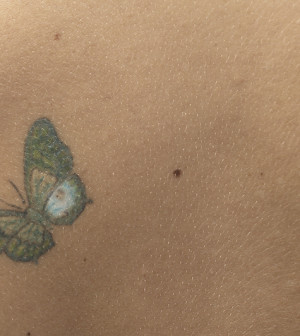- Navigating Your Midlife Crisis: Embracing New Possibilities
- City Raccoons Showing Signs of Domestication
- Mapping the Exposome: Science Broadens Focus to Environmental Disease Triggers
- One Week Less on Social Media Linked to Better Mental Health
- Your Brain Changes in Stages as You Age, Study Finds
- Some Suicide Victims Show No Typical Warning Signs, Study Finds
- ByHeart Formula Faces Lawsuits After Babies Sickened With Botulism
- Switch to Vegan Diet Could Cut Your Greenhouse Gas Emissions in Half
- Regular Bedtime Does Wonders for Blood Pressure
- Dining Alone Could Mean Worse Nutrition for Seniors
Prom Isn’t a Good Reason to Hit the Tanning Salon


A visit to a tanning salon is one way many American girls prepare for their high school proms, but experts warn that teens should think twice before getting into a tanning booth.
“The obsession with looking tan is causing some teenagers to place themselves at risk for skin cancers and premature aging, despite the fact that safe sunless tanners exist,” Dr. Lily Uihlein, a pediatric dermatologist at Loyola University Health System in Maywood, Ill., said in a recent university news release.
“There also are many misconceptions associated with indoor tanning, which are helping to perpetuate this habit,” she added.
One myth is that indoor tanning will reduce acne. While sun exposure may temporarily improve acne, it tends to flare up when the tan goes away, according to Loyola’s pediatric dermatologists.
Another misconception is that indoor tanning helps prevent vitamin D deficiency. Your skin manufacturers vitamin D when exposed to UVB light, but tanning beds mostly emit UVA light. The dermatologists say that vitamin D can also be obtained from certain foods and from supplements.
Many people mistakenly believe that a base tan prevents sunburns. But tans do not protect your skin from the harmful effects of the sun, and you still need to use sunscreen when you’re outdoors, according to the dermatologists.
Still, 30 million people use tanning salons in the United States each year. About 2.3 million of those customers are teens, according to the American Academy of Dermatology (AAD). Nearly 70 percent of tanning salon customers are white females, ages 16 to 29.
It’s been reported that people who use indoor tanning have a 59 percent increased risk of deadly melanoma skin cancer, according to the AAD.
“Indoor tanning is a legitimate health problem among this population,” Dr. Wendy Schumacher-Kim, a pediatric dermatologist at Loyola, said in the news release.
And, it’s a behavior that can become a habit. “When a person visits a tanning booth, the body releases endorphins. These chemicals produce the same feelings of euphoria or well-being that is felt when people use drugs or alcohol,” explained Schumacher-Kim.
More information
The U.S. Centers for Disease Control and Prevention has more about the dangers of indoor tanning.
Source: HealthDay
Copyright © 2025 HealthDay. All rights reserved.










